There was a time when talking about the countryside, people immediately thought of the image of bamboo fences. Now, that image is gradually disappearing in Hai Duong...
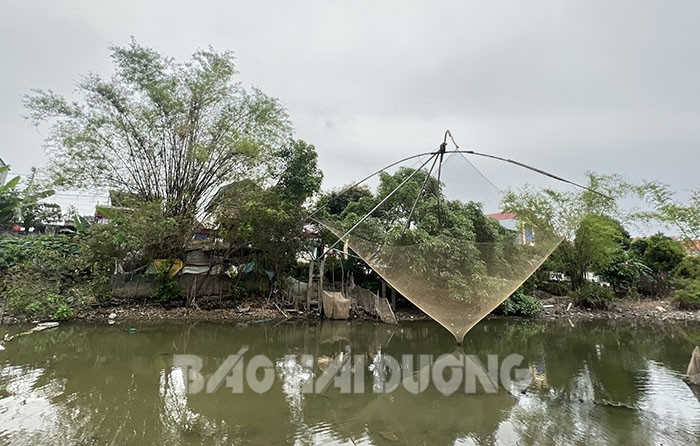
The idyllic, idyllic scene created by bamboo bushes and a raft next to the riverbank in rural Hai Duong is now very rare.
Over time, bamboo - one of the typical cultural symbols of Vietnamese villages - is gradually disappearing. However, in Hai Duong, the image and value of this tree is being preserved by some people and agencies.
To remember a time
In front of the path leading to Mr. Nguyen Van Khanh's spacious house in Bui Xa village, Doan Ket commune (Thanh Mien), there is a bamboo grove that has existed for more than a century. Inside his garden, there are two other bamboo groves that have been planted for decades. Over the years, the vitality of these bamboo groves has continued under Mr. Khanh's care. The old bamboo roots have withered, but there are bamboo shoots that reach up to the light. Occasionally, Mr. Khanh cuts and trims mature bamboo trees to make trellises for squash, squash, and chicken and duck coops. When summer comes, he chooses the best bamboo trees to bring home to make kites for his grandchildren to fly in the fields.
Neighbors have advised him to destroy the bamboo bushes many times to beautify the landscape, but Mr. Khanh always shook his head and refused. Although the value of bamboo is not as great as before, to him it holds many memories. “The bamboo bushes were planted by my grandfather, preserved by my father, and now by me. In the past, bamboo was everywhere around the house and on the street, but now there are only a few bushes left, so I can’t bear to destroy them. Bamboo has made countless items that have helped feed my family. I told my children that if they want to destroy them in the future, they should dig them up and plant them in the garden as a souvenir, teaching them to appreciate them,” Mr. Khanh confided.
Except for river banks and unused vacant lots, bamboo is still rare in the communities of the Northern Delta, including Hai Duong. In many villages in the province, people can no longer see the shadow of bamboo because the urbanization process is happening too quickly. Fortunately, there are still people like Mr. Khanh.
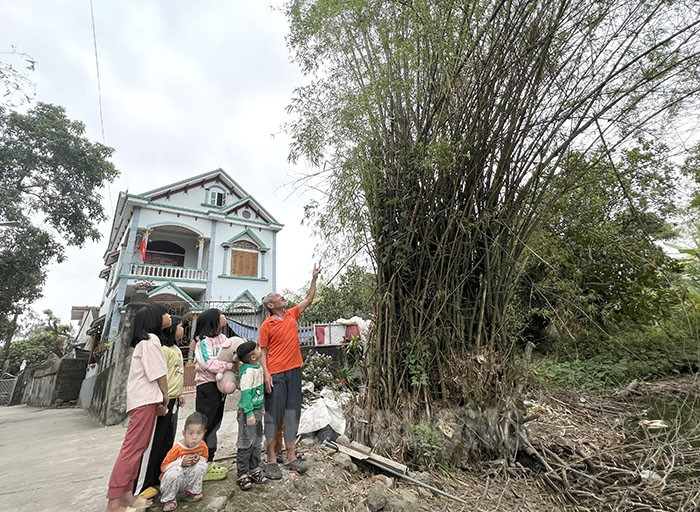
Bamboo bushes that have existed for more than a century are preserved and kept by Mr. Nguyen Van Khanh in Doan Ket commune (Thanh Mien).
Visiting some localities in Gia Loc, Tu Ky, Ninh Giang districts, I was impressed when many families, despite having built big and beautiful houses right next to the main road, still preserved the bamboo bushes that they had been associated with since their childhood. Some families living next to National Highway 37, passing through Hai Duong agricultural wholesale market, built brick walls around the bamboo roots in front of the gate, and placed a table and chairs underneath to sit and sell goods and rest. A household in Lien Dong village, Hong Quang commune (Thanh Mien), despite being rich, still kept a raft placed next to the bamboo bushes near the riverbank, a few steps from the gate to remember a difficult time in the past...
Even in Hai Duong City, there are a few people who still preserve bamboo roots that have been with them all their lives. Right at the beginning of lane 443 on Dien Bien Phu Street, there is an old bamboo bush that still witnesses the busy flow of people, vehicles, and trains passing by every day. Under this bamboo tree, an old woman sometimes sits and sells tea to cyclo drivers and motorbike taxi drivers. People living in the alley say that the owner of this bamboo bush is a couple who are at a rare age. They have moved to another street to live, most of the land area has been used to build shops for rent, but they are determined not to let anyone destroy the bamboo bush. Ms. Nguyen Thi Tam rides her bicycle to the market every day through this bamboo bush and shares: “In the past, there was a lot of bamboo in this area. People exploited it to make all kinds of utensils and items. Now, only this bamboo bush remains, so it is no different from a living witness to a difficult and arduous time that has passed.”
While many inner-city shops aim to design new spaces to attract customers, Smile View Coffee (2 Nguyen Trac Luan) has preserved and turned a large bamboo bush from decades ago into a highlight. Coming here with middle-aged friends to enjoy coffee, Mr. Nguyen Xuan Bac said: "It feels so peaceful. This space gives me the feeling of reliving the days with my parents and siblings living in a poor but affectionate countryside."
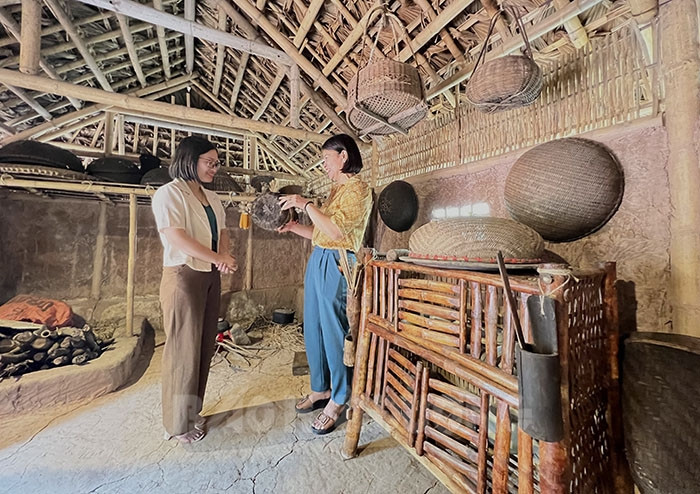
The ancient Vietnamese kitchen space at Hai Duong Provincial Museum is a place to preserve and display many types of bamboo utensils.
Wandering around to learn about people who are still interested in preserving bamboo, I - a person of the 8X generation, born and raised in a poor rural area in Tu Ky district - could not help but recall the past days. The generation like me returning to the countryside, if living in the countryside, bamboo was very familiar. There are many types of bamboo, but in my hometown or neighboring countryside, the most common are Vietnamese bamboo (small, hard, solid trunk) or Buong bamboo (large trunk, hollow core, hard core) and Van bamboo (low-growing bamboo, only suitable for making fences around the house). Vietnamese bamboo and Buong bamboo grow in tall ramparts on both sides of the road, in home gardens, outside the dike... Bamboo is familiar to the daily life and production of the people, with countless uses that few other plants can compare to. My grandfather told me that in the past, during the war, the thick bamboo fences around the village combined with deep trenches blocked the enemy's movement, creating a solid defense. Bamboo stems are used to make sticks, crossbows, bows and arrows, spike traps for enemies, and marching sticks for soldiers...
In ancient times, people used bamboo as the main material for building kitchens, houses, tents, cots, beds, ladders, barns for raising livestock and poultry, building bridges, and making fishing boats. Depending on the characteristics and stages of development of each type of bamboo, people combined it with other types of trees and vines to create a series of items for daily life and production such as: plows, harrows, trowels, baskets, water scoops, baskets, trays, trays, winnowing baskets, winnowing baskets, sieves, table cages, dining tables, cupboards, chopsticks, toothpicks, bamboo blinds, binding strips; rice mills, hoe handles, spades, earth-pounding mallets, threshing axes, shoulder poles, shoulder poles; fish traps, shrimp traps, yard brooms, duck fences, fly and locust swatters, bird and stork traps, and pipes. Even the shavings (bamboo core) in the process of whittling to make utensils are also used as dishwashing utensils.
In the past, our people used to choose small male bamboo trees with rough trunks to make canes for the elderly. We children often used bamboo to make kites to fly in the summer, cut bamboo into pieces to play with, and used bamboo shoots to make bracelets and necklaces... Every season, my mother would choose the best bamboo shoots to bring home to pickle with vinegar and chili, and only occasionally would she have the chance to cook them with duck meat, making the aroma spread throughout the neighborhood. My grandmother used bamboo leaves with grapefruit leaves, basil, lemongrass, mint, and cinnamon bark to make medicine to relieve colds and sinuses.
Nowadays, bamboo is mainly used in rattan and bamboo weaving and handicraft villages. Bamboo is planted to block waves on river banks. Farmers in many places still use bamboo to build house foundations and trellises for growing squash, pumpkin, and squash.
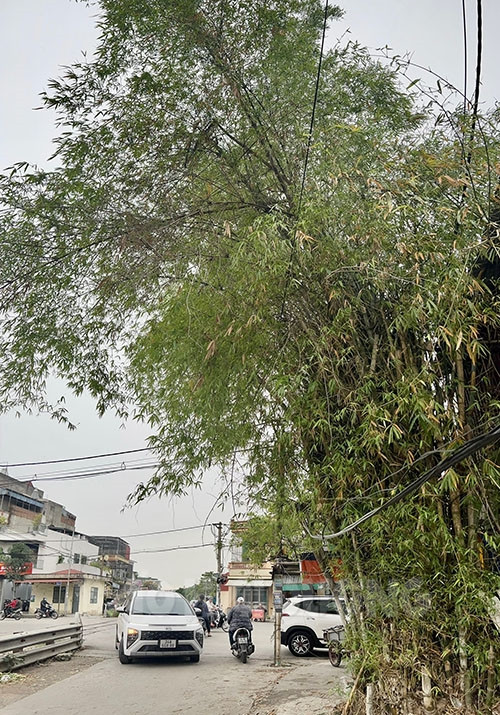
A bamboo grove at the entrance of lane 443 Dien Bien Phu street (Hai Duong city) has existed for many years.
Traditional education
Hai Duong Literature and Arts Magazine in June 2022 published an article "Bamboo" by historian Tang Ba Hoanh analyzing this plant in detail. According to the author of the article, in archaeological sites, people have seen traces of woven bamboo on prehistoric pottery. In ancient tombs of the late Dong Son culture, bamboo was seen woven like a bed, forming a coffin, this form of burial lasted until 1945... In the set of toys and folk beliefs from the pole, the fan branches, the flute, the bridge, the swing, the stilts are all made of bamboo. The tube containing the petitions and the sacred relics in the village communal house is also made from old bamboo tubes, turned and painted, and has existed for several centuries... In the resistance war against the Yuan army, the spear was a commonly used weapon because it had a long handle, a pointed tip, and a sharp blade. Nguyen Che Nghia made great achievements with this type of spear, later Coi Xuyen village (Gia Loc) had a custom of using bamboo sticks in the early spring instead of spears to preserve the tradition of fighting the enemy of his ancestors. During the resistance war against the French in the Central Highlands, Hero Nup defeated the French many times with bamboo arrows... "The benefits of bamboo are such that it soon entered literature and art such as: folk songs, proverbs, legends, poems, music, painting, architecture, sculpture... Bamboo grows exceptionally in all environments of the country, bringing countless benefits that many generations of Vietnamese people rely on the shade of bamboo trees to survive and develop", historian Tang Ba Hoanh wrote.
The preservation and maintenance of the historical and cultural values of bamboo has received attention from a number of relevant units. For many years, the Hai Duong Provincial Museum has worked hard to collect household utensils and agricultural tools made from bamboo. In the campus, the unit has planted two bamboo clumps and has also restored the "Ancient Vietnamese Kitchen Space" and "Mr. Pham Sy Y's House" (a house representing the middle class of the 19th century) with many artifacts made from bamboo. "From 2016 to now, the Provincial Museum has organized two special topics to introduce agricultural tools and traditional occupations, most of which are related to bamboo. These events have attracted a significant number of people and tourists to visit and learn, especially the young generation", informed Ms. Le Thi Thuy Ngoc, Deputy Head of the Provincial Museum's Exhibition Department.
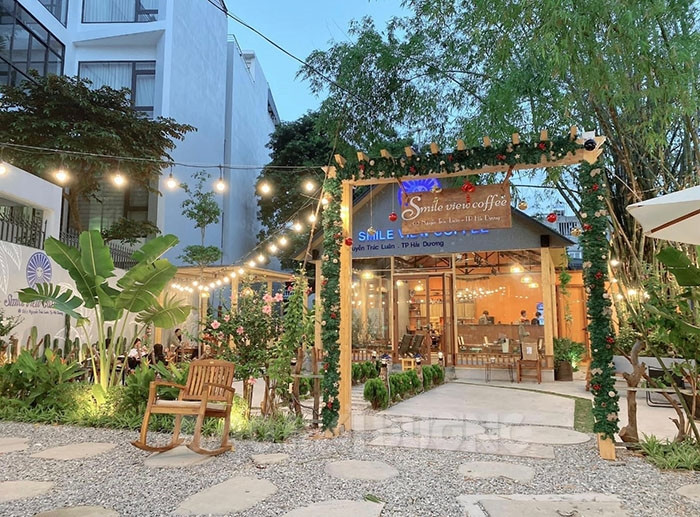
Smile view coffee shop becomes intimate and peaceful thanks to preserving and maintaining bamboo bushes.
At the Bia Temple, the Cam Giang District Relic Management Board has planted a row of more than 100 bamboo trees, now about 2.5 m high. Planting bamboo is not only intended to make the relic space more intimate but also to contribute to preserving historical and cultural values related to bamboo, to educate traditions for today's and future generations. The unit has been using bamboo to decorate the relic grounds, recreating the Hai Duong Town Examination School in the 19th century...
DAWN